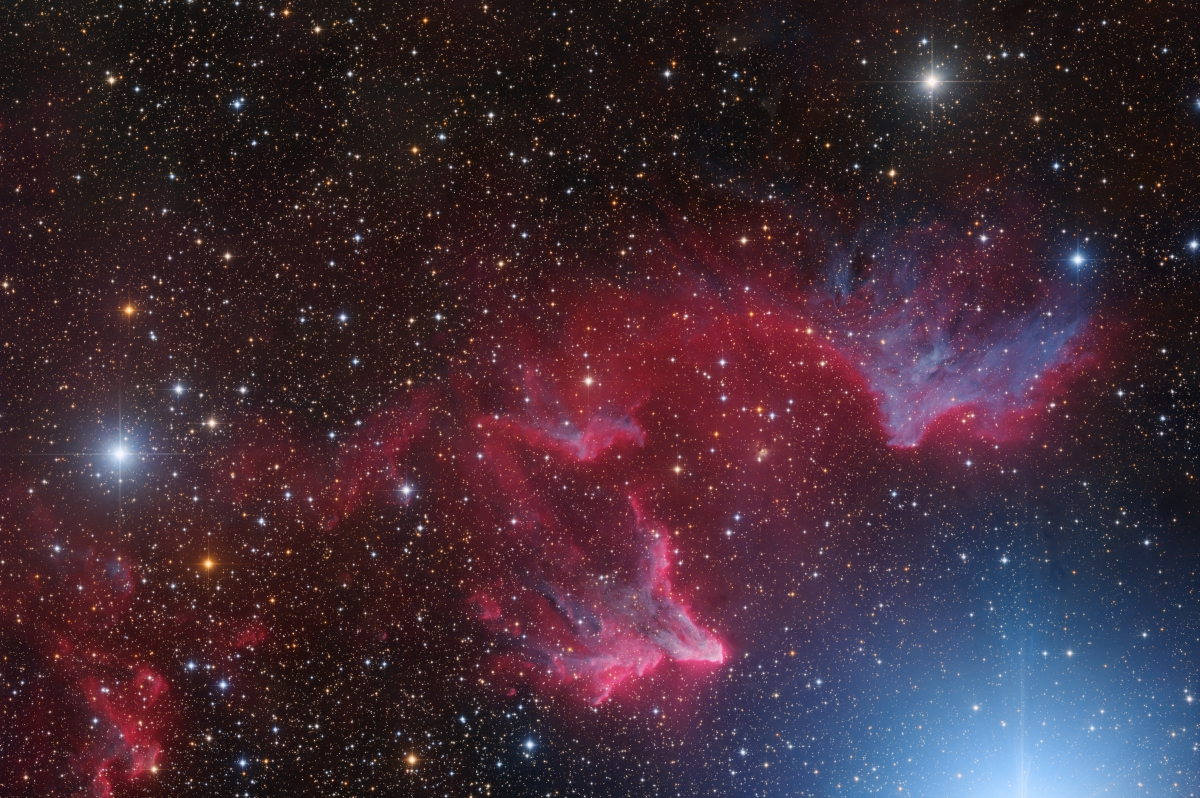
[back] IC 59/63 in Cassiopeia
Uncroped
100% version /
Unbeschnittene 100%-Version (6030 x 4010 Pixel)
Annotated Version
/Beschriftete Version (60030 x 4010 Pixel)

|
(c) 2025 All astro photo images are copyrighted. They may not be used or reproduced without explicit written permission from the authors. |
|
300" |
|
About this Image / Über dieses Bild
| CCD: | Omegon veTEC410c |
| Image Type, Orientation: | RGB-HaOIII Composite, North is at 12:00h |
| Exposure time: | RGB: 78x300s, HaOIII: 85x300s (13:35 total) |
| Exposure date: |
October 1st...5th 2024 |
| Location: | Capella Observatory at Skinakas, Crete/Greece,robotic (with babysitting from Ireland during a Van trip |
| Filter: | RGB: Internal Bayer-Matrix, HA/OIII: STC Astro Duo-Narrowband Filter |
| Instrument: | Ganymed 60cm-Hypergraph in primary focus (f=1840 mm) |
|
Final Image Seeing (FWHM): |
1.7" |
| Photographer: | Josef Pöpsel, Frank Sackenheim, Stefan Binnewies |
|
Remarks: |
Near the star
Gamma Cassiopeiae lies a nebula that seems to wrap around it, cataloged as
IC 59 and IC 63. IC 59 is the upper of the two, showing a clear blue glow,
while IC 63 appears below it with a distinct reddish hue. It is obvious that
both nebulae are associated in some way with Gamma Cassiopeiae. Being a
B0-type star, it emits strong UV radiation capable of making surrounding
hydrogen gas glow, while the color of the blue reflection nebula matches the
star well, as its light is scattered by dust particles there. What seems
puzzling, however, is the imbalance: one nebula shows a stronger reflection
component with less Hα emission, while the other shows the opposite.
Originally, it was assumed that both nebulae lie in the same plane as Gamma
Cassiopeiae. A relatively recent study by Eiermann et al. in 2024 showed
that the nebulae are actually at slightly different distances: IC 63 lies
behind Gamma Cassiopeiae at about 2.3 pc, while IC 59 is in front of it at
4.15 pc. This explains the different appearance of the two nebulae pretty
well. |
|
Bemerkungen: |
Nahe des Sterns Gamma Cassiopeiae
schmiegt sich ein Nebel um diesen Stern, der im IC-Katalog einmal die Nummer
59 und einmal die Nummer 63 erhalten hat. IC 59 ist der obere der beiden
Nebel, jener, der deutlich mehr Blau zeigt, während IC 63 als der rötlichere
Nebel darunter erscheint. Dass beide Nebel in irgendeiner Form mit Gamma
Cassiopeiae assoziiert sind, liegt auf der Hand. Der Stern gehört zum
Spektraltyp B0 und verfügt über eine intensive UV-Strahlung, die
Wasserstoffgas zum Leuchten anregen kann. Andererseits passt die Farbe des
blauen Reflexionsnebels gut zum Stern, da hier sein Licht an Staubpartikeln
gestreut wird. Merkwürdig erscheint jedoch, dass es ein Ungleichgewicht
gibt: Einer der Nebel zeigt einen höheren Reflexionsanteil und weniger Hα,
während es beim anderen umgekehrt ist. Ursprünglich nahm man an, dass beide
Nebel in einer Ebene mit Gamma Cassiopeiae liegen. Erst eine relativ neue
Studie von Eiermann et al. aus dem Jahr 2024 konnte zeigen, dass die Nebel
tatsächlich leicht unterschiedlich entfernt sind: So liegt IC 63 hinter
Gamma Cassiopeiae, in einem Abstand von etwa 2,3 pc, während sich IC 59
davor befindet, in einem Abstand von 4,15 pc. Das erklärt das
unterschiedliche Aussehen der beiden Nebel recht gut. |
Back to the Diffuse Nebulae Overview / Zurück zur Diffuse-Nebel-Übersichtsseite